Text
Chinese statuette of a horse
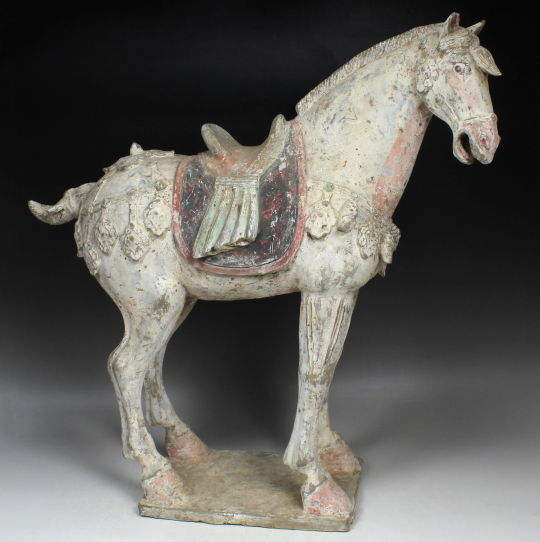
ITEM
Statuette of a horse
MATERIAL
Pottery
CULTURE
Chinese, Tang Dynasty
PERIOD
618 - 907 A.D
DIMENSIONS
560 mm x 530 mm x 200 mm
CONDITION
Good condition. Includes Thermoluminescence test by Laboratory Kotalla (Reference 02PR101220)
PROVENANCE
Ex Belgian private collection (2022), Ex English art gallery, Ex English private collection, D.R, acquired in 1990s
The Tang Dynasty, which ruled China from 618 to 907 AD, is often regarded as one of the most glorious periods in Chinese history, characterized by political stability, economic prosperity, and remarkable cultural achievements. Established by the Li family, the dynasty saw significant advancements in various fields, including poetry, painting, calligraphy, and technology. The Tang Dynasty was renowned for its cosmopolitanism, with influences from Central Asia, India, and the Middle East contributing to its vibrant cultural landscape. Under Tang rule, China experienced a golden age of literature and art, with figures like Li Bai and Du Fu flourishing in poetry and artists such as Wu Daozi making significant contributions to painting.
During the Tang Dynasty, the tradition of producing horse statuettes continued, reflecting the enduring significance of horses in Chinese society. These horse statuettes, often referred to as Minqi horse sculptures, maintained the artistic excellence established in earlier periods and further developed under Tang patronage.
Read the full article
#ancient#ancientart#ancienthistory#artefact#artifact#ancientartifacts#antiquities#antiquity#art#artobject#ancientworld#history#classical#archaeology#statue#statuette#chinese#tang#dynasty#animal#horse#asiatic#china#pottery#vessel#minqi#ancientchina
1 note
·
View note
Text
Roman relief of Medusa and Hercules knot

ITEM
Relief of Medusa and Hercules knot
MATERIAL
Limestone
CULTURE
Roman
PERIOD
2nd - 3rd Century A.D
DIMENSIONS
465 mm x 362 mm x 103 mm (without stand)
CONDITION
Good condition. Includes stand
PROVENANCE
Ex English private collection, P.A., Hertfordshire, specialist collector of Greek Art, acquired between 1980s - 1990s
In Roman mythology, Medusa was a Gorgon, a creature with snakes for hair whose gaze could turn anyone to stone. While the Greek mythological tradition portrayed Medusa primarily as a monstrous figure, in Roman art and culture, she often took on a more complex and varied role. The Roman interpretation of Medusa frequently blended elements of her monstrous aspect with her protective qualities, leading to a range of representations in various contexts.
One common motif in Roman art is the use of Medusa's head as a protective symbol. The image of Medusa's head, with its petrifying gaze, was believed to ward off evil and protect against harm. It appeared on a variety of objects, including household items like door knockers, as well as on armor and shields worn by soldiers. This protective aspect of Medusa was derived from her ability to avert danger with her gaze, turning potential threats to stone before they could harm the beholder.
In addition to her protective role, Medusa also featured prominently in Roman architectural reliefs and decorative elements.
Read the full article
#ancient#ancientart#ancienthistory#artefact#artifact#ancientartifacts#antiquities#antiquity#art#artobject#ancientrome#ancientworld#history#classical#archaeology#roman#limestone#relief#medusa#hercules#knot#gorgon
0 notes
Text
Roman mosaic depicting a bird

ITEM
Mosaic depicting a bird
MATERIAL
Tesserae
CULTURE
Roman
PERIOD
3rd Century A.D
DIMENSIONS
400 mm x 440 mm x 40 mm
CONDITION
Good condition
PROVENANCE
Ex Swiss private collection, E.O., Geneve, acquired before 1990s
Roman mosaics are renowned for their intricate designs and enduring beauty, often depicting various motifs that reflect the cultural and artistic sensibilities of the time. Among these motifs, the depiction of birds holds particular significance in Roman art. Birds were commonly featured in Roman mosaics for their symbolic meanings, which varied depending on the species portrayed. The birds motif in Roman mosaics served both decorative and symbolic purposes, enriching the visual appeal of the artwork while conveying deeper layers of meaning to the viewer.
In Roman art, birds were frequently associated with themes of freedom, transcendence, and divine communication. Depictions of birds such as doves, eagles, and peacocks symbolized different aspects of Roman society and belief systems. For example, doves were often associated with peace and love, while eagles were emblematic of power and authority, often representing the Roman state and its military prowess. Peacocks, with their vibrant plumage, were symbols of immortality and resurrection in Roman mythology, associated with deities such as Juno and Hera.
The
Read the full article
#ancient#ancientart#ancienthistory#artefact#artifact#ancientartifacts#antiquities#antiquity#art#artobject#ancientrome#ancientworld#history#classical#archaeology#roman#mosaic#bird#tessera#tesserae#animal
3 notes
·
View notes
Text
Greek aryballos depicting a rider with horse

ITEM
Aryballos depicting a rider with horse
MATERIAL
Pottery
CULTURE
Greek, Corinthian
PERIOD
7th Century B.C
DIMENSIONS
50 mm x 54 mm diameter
CONDITION
Good condition
PROVENANCE
Ex Swiss private collection, M. H. D., acquired between since 1919
BIBLIOGRAPHY
BRITISH MUSEUM Collection Online, Accession number 1864,1007.1423 and 1864,1007.1431
The Greek aryballos, particularly during the Corinthian period, stands as a testament to the skill and artistry of ancient Greek ceramic craftsmanship. An aryballos is a small, globular vessel designed for holding oil or perfumes, characterized by its narrow neck and rounded body. In the Corinthian period, spanning from the 7th to the mid-6th century BCE, Corinth emerged as a prominent center for pottery production, and the aryballos became a popular form of artistic expression within this context.
Corinthian aryballoi are renowned for their distinctive black-figure technique, wherein the figures and decorative elements are painted in black slip against the natural red clay background. The scenes depicted on these vessels often revolve around mythological narratives, such as battles, athletic competitions, or religious rituals. The intricate details and fine craftsmanship of Corinthian aryballoi reflect the technical mastery achieved by the potters of this era.
In
Read the full article
#ancient#ancientart#ancienthistory#artefact#artifact#ancientartifacts#antiquities#antiquity#art#artobject#ancientgreece#ancientworld#history#classical#archaeology#greek#greece#pottery#vessel#rider#horse#aryballos#corinthian
2 notes
·
View notes
Text
Roman shipwreck amphora, Type Dressel 1B

ITEM
Shipwreck amphora, Type Dressel 1B
MATERIAL
Pottery
CULTURE
Roman, Republican period
PERIOD
2nd – 1st Century B.C
DIMENSIONS
110 cm x 29 cm (without stand), 117 cm x 29 cm (with stand)
CONDITION
Good condition. Small restorations in the handles and a crack in the lower part of the piece, the crack is superficial, the piece is not damaged inside and its condition is not in danger. See pictures. Includes stand
PROVENANCE
Ex Belgian private collection, S., Ghent, Ex C. Varosi Gallery, Brussels (1999)
Roman amphoras of the Dressel 1 type represent a significant archaeological find that sheds light on ancient Roman trade and transportation practices. Named after the German archaeologist Heinrich Dressel, who first categorized them in the late 19th century, Dressel 1 amphoras were widely used for the storage and transportation of goods throughout the Roman Empire, particularly during the 1st century BCE and the early 1st century CE.
Characterized by their distinctive shape and design, Dressel 1 amphoras typically feature a long, cylindrical body with a pointed or rounded bottom, a narrow neck, and two small handles positioned near the neck. They were primarily used for the transport of liquid goods such as wine, olive oil, and fish sauce, although they were occasionally employed for solid commodities as well. The capacity of Dressel 1 amphoras varied, but they typically held between 20 to 30 liters of liquid.
Archaeological
Read the full article
#ancient#ancientart#ancienthistory#artefact#artifact#ancientartifacts#antiquities#antiquity#art#artobject#ancientrome#ancientworld#history#classical#archaeology#roman#shipwreck#amphora#dressel#vessel#pottery
0 notes
Text
Roman statuette of Harpocrates

ITEM
Statuette of Harpocrates
MATERIAL
Marble
CULTURE
Roman
PERIOD
1st - 2nd Century A.D
DIMENSIONS
110 mm x 60 mm x 34 mm
CONDITION
Good condition
PROVENANCE
Ex Swiss private collection, acquired between 1970 - 1990
In the Roman period, Harpocrates continued to be a significant deity, albeit with adaptations and reinterpretations influenced by both Roman and Egyptian religious traditions. Harpocrates was originally an ancient Egyptian god associated with silence, secrets, and confidentiality. In the Hellenistic and Roman periods, the cult of Harpocrates spread throughout the Mediterranean, and the god underwent syncretism with various Greek and Roman deities, blending cultural and religious influences.
In Roman art and mythology, Harpocrates is often depicted as a young boy with a finger to his lips, symbolizing the gesture of silence. The Romans associated him with the concept of confidentiality and discretion, making him a popular figure in various contexts, including funerary art and domestic worship. The Roman adaptation of Harpocrates integrated elements of the original Egyptian symbolism with the broader Greco-Roman religious landscape, showcasing the fluidity and adaptability of ancient religious beliefs during this period.
Devotion to Harpocrates also found a place in mystery cults and esoteric traditions in the Roman Empire.
Read the full article
#ancient#ancientart#ancienthistory#artefact#artifact#ancientartifacts#antiquities#antiquity#art#artobject#ancientrome#ancientworld#history#classical#archaeology#roman#marble#statuette#statue#figure#figurine#harpocrates
3 notes
·
View notes
Text
Romano-Egyptian cartonnage mummy mask depicting a female head

ITEM
Romano-Egyptian cartonnage mummy mask depicting a female head
MATERIAL
Linen and Gesso
CULTURE
Egyptian, Roman period
PERIOD
1st Century B.C – 1st Century A.D
DIMENSIONS
208 mm x 200 mm x 200 mm (without stand)
CONDITION
Good condition
PROVENANCE
Ex English private collection, Ex Christie’s, London, April 2000, lot 59 (part lot), Ex Belgian private collection, Ex Bonhams
During the Roman period in Egypt, which spanned from the 1st century BCE to the 4th century CE, a unique blend of Egyptian and Greco-Roman artistic influences emerged. This period saw the production of cartonnage mummy masks that often depicted female heads, showcasing a fusion of traditional Egyptian religious beliefs with the cultural impact of the Roman Empire. Cartonnage was a material made from layers of linen or papyrus soaked in plaster, creating a rigid surface suitable for painting and decoration.
The female heads depicted on these mummy masks during the Roman period often reflected the idealized beauty standards of the time. These masks were not just functional elements for preserving the deceased's features, but also served a ritualistic and symbolic purpose. The depictions frequently incorporated Roman hairstyles and fashion trends, showcasing the blending of cultural elements.
Read the full article
#ancient#ancientart#ancienthistory#artefact#artifact#ancientartifacts#antiquities#antiquity#art#artobject#ancientrome#ancientworld#history#classical#archaeology#roman#egyptian#romano-egyptian#mummy#sarcophagus#female#head#cartonnage
2 notes
·
View notes
Text
Roman statuette of an eagle on pedestal
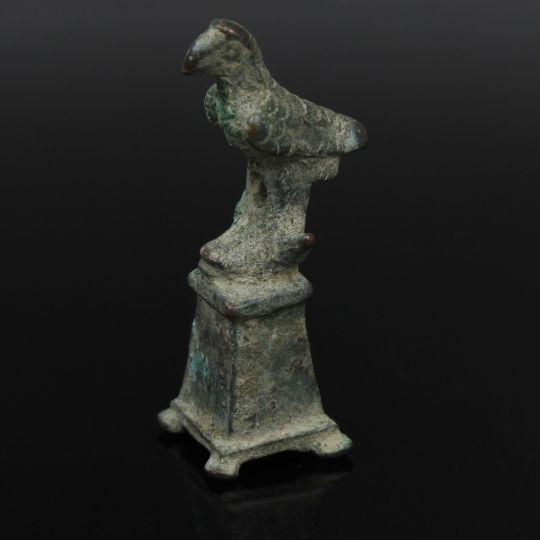
ITEM
Statuette of an eagle on pedestal
MATERIAL
Bronze
CULTURE
Roman
PERIOD
1st - 3rd Century A.D
DIMENSIONS
60 mm x 20 mm x 20 mm
CONDITION
Good condition
PROVENANCE
Ex German private collection, acquired before 1980s
In the Roman period, bronze statuettes of eagles held significant cultural and symbolic importance. The eagle was a powerful and revered symbol in Roman society, representing strength, courage, and military prowess. As the national emblem of Rome, the eagle was associated with the Roman legions and the divine authority of the Roman state. Consequently, bronze statuettes of eagles were commonly used as military standards, known as "aquilae," carried by Roman legions as symbols of honor and allegiance to the empire.
These bronze eagle statuettes were meticulously crafted, showcasing the artistic skill and attention to detail characteristic of Roman artistry. Typically small in size, these statuettes featured finely rendered feathers, outstretched wings, and sharp talons, capturing the majestic and imposing nature of the bird of prey. The craftsmanship of these statuettes reflected the Romans' appreciation for realism and their ability to infuse lifelike qualities into their art.
Beyond their military significance, bronze eagle statuettes also found a place in various aspects of Roman life, including as decorative elements in homes, public spaces, and temples.
Read the full article
#ancient#ancientart#ancienthistory#artefact#artifact#ancientartifacts#antiquities#antiquity#art#artobject#ancientrome#ancientworld#history#classical#archaeology#roman#statuette#eagle#animal#military#legionary#legion#pedestal#statue#figure
1 note
·
View note
Text
Etruscan anatomical votive model of a foot

ITEM
Anatomical votive model of a foot
MATERIAL
Terracotta
CULTURE
Etruscan
PERIOD
5th - 4th Century B.C
DIMENSIONS
105 mm x 85 mm x 205 mm
CONDITION
Good condition
PROVENANCE
Ex Paul Suttman collection. Acquired by Suttman in the 1960's when he lived in Italy as a fellow ofthe American Academy of Rome. Three time recipient of the prestigious Prix de Rome Paul Suttman (1933-1993) was an internationally known American sculptor who produced many impressionistic figurative works in bronze. Mr. Suttman's work is represented in the Museum of Modern Art, the Morgan Library, the University of Michigan Museum of Art, and the Hirshhorn Museum and Sculpture Garden in Washington
In antiquity, the cult of a mother goddess and divine nurse (or kourotrophos) was prevalent throughout the Mediterranean, from Asia Minor to Sicily and from southern Russia to North Africa. The kourotrophos directly intervened in the affairs of men, her domain embracing all aspects of life and death.
From early in the Archaic period, images of kourotrophoi frequently appeared in the art of central and Southern Italy. These depictions commonly took the form of a seated female holding a swaddled child. Diana, Mater Matuta, Minerva, Persephone, Turan, and Uni are some of the goddesses worshipped as kourotrophoi in Italy.
Terracotta votive statues, statuettes, heads, busts, infants, and anatomical parts were common dedications to a kourotrophos at her sanctuaries in Etruria, Latium, and Campania.
Read the full article
#ancient#ancientart#ancienthistory#artefact#artifact#ancientartifacts#antiquities#antiquity#art#artobject#ancientworld#history#classical#archaeology#etruria#etruscan#anatomical#votive#foot#exvoto
2 notes
·
View notes
Text
Greek figurine of a little Eros riding on a dolphin, holding a lyre

ITEM
Figurine of a little Eros riding on a dolphin, holding a lyre with remains of polychromy
MATERIAL
Pottery
CULTURE
Greek
PERIOD
4th - 3rd Century B.C
DIMENSIONS
145 mm x 140 mm x 65 mm
CONDITION
Good condition
PROVENANCE
Ex American private collection, acquired before 2000s
The depiction of Eros riding on a dolphin while holding a lyre is a classical motif from ancient Greek art that symbolizes the association of love, music, and the sea. Eros, the Greek god of love and desire, is often portrayed in various forms, and the image of him riding a dolphin is a representation of his playful and mischievous nature. The dolphin, a creature associated with the sea, was considered sacred to the goddess Aphrodite, who is closely linked to Eros in Greek mythology. This imagery not only emphasizes Eros's connection to the watery realms but also underscores the harmonious and poetic aspects of love.
The inclusion of the lyre in Eros's hands adds another layer of meaning to the composition. The lyre, a stringed musical instrument, was associated with Apollo, the god of music and arts. The combination of Eros with the lyre suggests a fusion of love and artistic expression, highlighting the transformative and inspiring power of love in the realm of creativity.
Read the full article
#ancient#ancientart#ancienthistory#artefact#artifact#ancientartifacts#antiquities#antiquity#art#artobject#ancientgreek#ancientworld#history#classical#archaeology#greek#eros#dolphin#figurine#statuette#statue#lyre#pottery#vessel
0 notes
Text
Greek funerary diadem
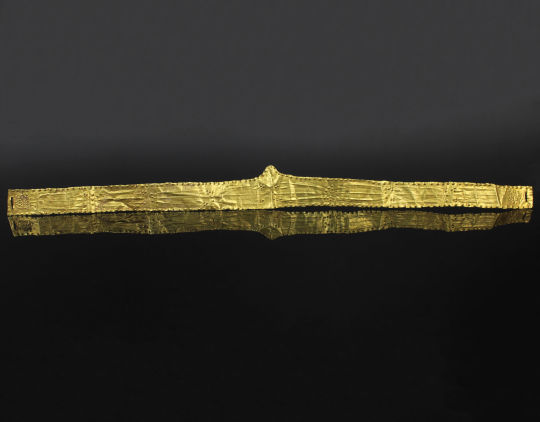
ITEM
Funerary diadem
MATERIAL
Gold
CULTURE
Greek
PERIOD
4th - 3rd Century B.C
DIMENSIONS
250 mm x 22 mm, 3,9 gr
CONDITION
Good condition
PROVENANCE
Ex French private collection, acquired before 1990s
BIBLIOGRAPHY
The Metropolitan Museum of Art, Accession number 74.51.3535. The British Museum Collection Online, Accession number 1877,0910.60, 1877,0910.58 and 1877,0910.77.
In ancient Greek culture, the use of gold funerary diadems was a prominent practice, particularly during the Classical and Hellenistic periods. These diadems were elaborate headpieces made of gold and were often crafted with intricate designs and symbolic elements. They held a significant role in funerary customs, symbolizing the deceased's elevated status, wealth, and connection to the divine. Gold, as a precious metal, was associated with the gods in Greek mythology, and its use in funerary diadems reflected the belief in an afterlife where the deceased would continue to enjoy divine favor.
The designs of these diadems were diverse, featuring motifs such as floral patterns, mythological scenes, and symbols associated with immortality. The intricate craftsmanship demonstrated the artistic skills of ancient Greek goldsmiths, who employed techniques such as repoussé and filigree to create these exquisite pieces.
Read the full article
#ancient#ancientart#ancienthistory#artefact#artifact#ancientartifacts#antiquities#antiquity#art#artobject#ancientworld#history#classical#archaeology#greek#greece#ancientgreece#gold#funerary#diadem#ancientjewelry#jewel#jewelry
0 notes
Text
Egyptian scarab of pharaoh Akhenaten with and Udjat eye on the back
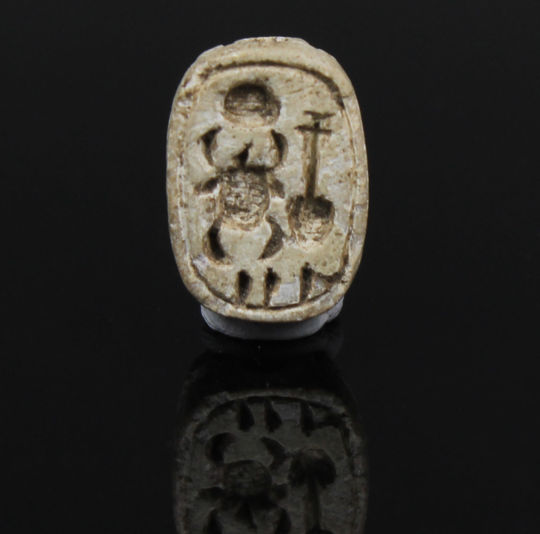
ITEM
Scarab of pharaoh Akhenaten with and Udjat eye on the back
MATERIAL
Steatite
CULTURE
Egyptian
PERIOD
Amarna Period, 14th Century B.C
DIMENSIONS
14 mm x 8 mm
CONDITION
Good condition
PROVENANCE
Ex Museum Exhibiton of the Arbeitsgruppe für Biblische Archäologie, Germany (Deaccession)
Akhenaten, also known as Amenhotep IV, was an ancient Egyptian pharaoh who reigned during the 18th dynasty. He is particularly famous for his radical religious reforms during the Amarna Period (approximately 1353-1336 BCE). Akhenaten introduced a monotheistic religion centered around the worship of the sun disk, Aten, and he moved the Egyptian capital from Thebes to a newly established city called Akhetaten (modern-day Amarna). This period marked a significant departure from the traditional polytheistic beliefs of ancient Egypt. Akhenaten's reign also saw artistic changes, with a more naturalistic style evident in depictions of the royal family. His successor, Tutankhamun, eventually reversed many of these reforms after Akhenaten's death, restoring the old gods and traditions, making the Amarna Period a unique and transformative episode in Egyptian history.
The Udjat Eye, often called the "Eye of Horus" or the "Eye of Ra," is a powerful symbol in ancient Egyptian mythology and is closely associated with protection, healing, and restoration.
Read the full article
#ancient#ancientart#ancienthistory#artefact#artifact#ancientartifacts#antiquities#antiquity#art#artobject#ancientworld#history#classical#archaeology#scarab#udjat#akhenaten#pharaoh#steatite#amarna#egypt#egyptian
0 notes
Text
Roman relief with togate
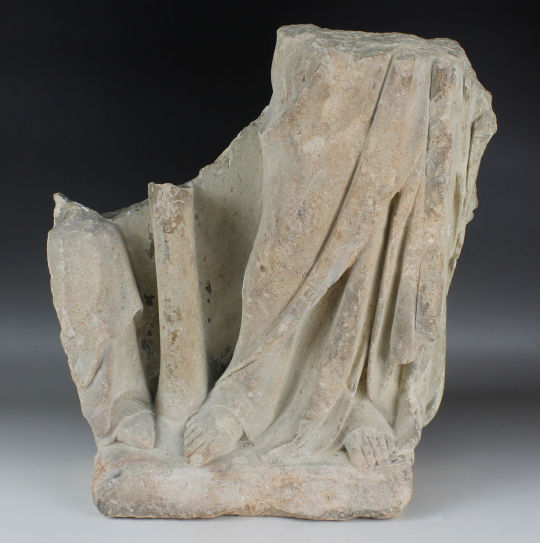
ITEM
Relief with togate
MATERIAL
Limestone
CULTURE
Roman
PERIOD
1st - 3rd Century A.D
DIMENSIONS
355 mm x 350 mm x 125 mm
CONDITION
Good condition. Restoration to join the two pieces together.
PROVENANCE
Ex French private collection, G., Family of architects, acquired before 1980s
Roman reliefs with togate figures often depict scenes from Roman life, showcasing individuals dressed in the distinctive Roman toga, a garment worn exclusively by Roman citizens. The toga was a symbol of Roman citizenship and was typically worn on formal occasions. In reliefs, togate figures are commonly portrayed in various social, political, or ceremonial settings, providing a glimpse into the cultural and societal norms of ancient Rome.
These reliefs serve as valuable historical and artistic artifacts, offering insights into the clothing styles, social hierarchies, and daily life of the Roman people. The toga itself was a draped garment made from a large piece of cloth and was worn in a specific manner, with variations in style and color indicating the wearer's social status and the nature of the event.
Read the full article
#ancient#ancientart#ancienthistory#artefact#artifact#ancientartifacts#antiquities#antiquity#art#artobject#ancientrome#ancientworld#history#classical#archaeology#roman#limestone#relief#togate
1 note
·
View note
Text
Etruscan sheet depicting a procession of warriors carrying spears and shields accompanied by charioteers with Silenus

ITEM
Sheet decoration, possibly a belt fitting, with repoussé technic. Depicts a procession of warriors carrying spears and shields accompanied by charioteers with Silenus
MATERIAL
Bronze
CULTURE
Etruscan
PERIOD
7th - 5th Century B.C
DIMENSIONS
71 mm x 323 mm (without stand)
CONDITION
Good condition. Includes stand
PROVENANCE
Ex Dutch private collection, J.T., collected before 1980s
BIBLIOGRAPHY
THE BRITISH MUSEUM Collection, accession number 1850,0227.15.b
Etruscan processions were religious and cultural events held in the ancient Etruscan civilization, which thrived in the region of Etruria in what is now Italy, roughly between the 8th and 3rd centuries BCE. These processions were a significant part of Etruscan religious and social life, offering a fascinating glimpse into their culture.
Key aspects of Etruscan processions included their primary religious purpose, involving rituals to honor various gods through music, dance, and song. Priests and priestesses played pivotal roles in organizing and conducting these rituals, often carrying sacred objects and statues of deities in the procession. Participants and religious leaders wore special attire adorned with religious symbols, and these processions held both religious significance and social importance, fostering community gatherings and strengthening social bonds.
Read the full article
#ancient#ancientart#ancienthistory#artefact#artifact#ancientartifacts#antiquities#antiquity#art#artobject#etruria#ancientworld#history#classical#archaeology#etruscan#silenus#bronze#warrior#shield#procession#belt
2 notes
·
View notes
Text
Roman military helmet face guard fragment with shield ornament
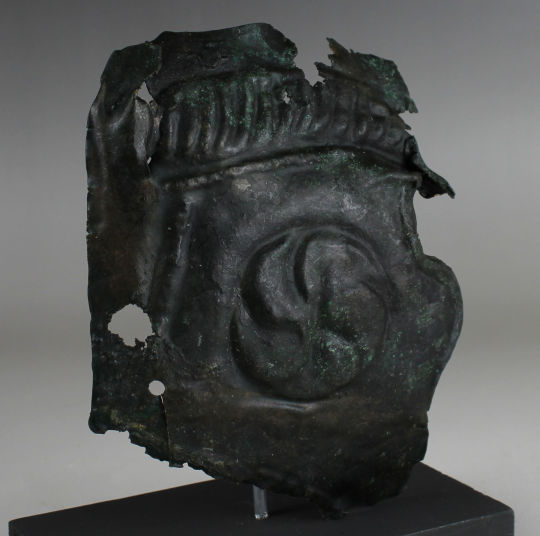
ITEM
Military helmet face guard fragment with shield ornament
MATERIAL
Bronze
CULTURE
Roman
PERIOD
3rd Century A.D
DIMENSIONS
130 mm x 110 mm
CONDITION
Good condition
PROVENANCE
Ex Alison Barker private collection, a retired London barrister, acquired between 1960s - 1990s
BIBLIOGRAPHY
RUCINSKI, E., Get the picture?: Iconography of cheek pieces on Roman Imperial cavalry helmets, Journal of Roman Military Equipment Studies, Fig. 12
Roman military equipment is famous for its abundance of depictions rife with symbolical content. The so-called cavalry sports equipment, which used to be seen as being solely parade armour, can be distinguished from the infantry equipment not only by its function, but also by its design. There are numerous surviving heavily ornamented parts of Roman cavalry equipment and a number of studies have been published on their purpose and decoration. Whether the ornamented equipment belonged to parade armour or was also worn in battle is still under discussion. One of those groups contains the helmets, of which a relatively large number of different variations exist. Apart from the calotte with its neck guard, the loosely attached cheek pieces were also an essential part of the helmet. Cheek pieces as protective elements were used both for infantry and cavalry helmets.
Read the full article
#ancient#ancientart#ancienthistory#artefact#artifact#ancientartifacts#antiquities#antiquity#art#artobject#ancientrome#ancientworld#history#classical#archaeology#roman#military#legion#legionary#helmet#army#mask#face#bronze#arms#armour#cavalry
0 notes
Text
Roman military helmet face mask fragment with Jupiter's eagle

ITEM
Military helmet face mask fragment with Jupiter's eagle
MATERIAL
Bronze
CULTURE
Roman
PERIOD
3rd Century A.D
DIMENSIONS
180 mm x 123 mm
CONDITION
Good condition
PROVENANCE
Ex Alison Barker private collection, a retired London barrister, acquired between 1960s - 1990s
BIBLIOGRAPHY
RUCINSKI, E., Get the picture?: Iconography of cheek pieces on Roman Imperial cavalry helmets, Journal of Roman Military Equipment Studies
Roman military equipment is famous for its abundance of depictions rife with symbolical content. The so-called cavalry sports equipment, which used to be seen as being solely parade armour, can be distinguished from the infantry equipment not only by its function, but also by its design. There are numerous surviving heavily ornamented parts of Roman cavalry equipment and a number of studies have been published on their purpose and decoration. Whether the ornamented equipment belonged to parade armour or was also worn in battle is still under discussion. One of those groups contains the helmets, of which a relatively large number of different variations exist. Apart from the calotte with its neck guard, the loosely attached cheek pieces were also an essential part of the helmet. Cheek pieces as protective elements were used both for infantry and cavalry helmets.
Read the full article
#ancient#ancientart#ancienthistory#artefact#artifact#ancientartifacts#antiquities#antiquity#art#artobject#ancientrome#ancientworld#history#classical#archaeology#roman#military#legion#legionary#helmet#jupiter#eagle#army#mask#face#bronze#arms#armour
9 notes
·
View notes
Text
Greek double spouted askos with dolphins

ITEM
Double spouted askos with dolphins
MATERIAL
Pottery
CULTURE
Greek, Daunian
PERIOD
3rd Century B.C
DIMENSIONS
213 mm x 180 mm x 160 mm.
CONDITION
Good condition, small hole in the dolphins' side
PROVENANCE
Ex Swiss private collection, family property since the 1970s. Part of the collection was on loan to the Archaeological Collection of the University of Zurich until the end of 2022.
Read the full article
#ancient#ancientart#ancienthistory#artefact#artifact#ancientartifacts#antiquities#antiquity#art#artobject#ancientgreece#ancientworld#history#classical#archaeology#greek#greece#pottery#vessel#askos#spouted#dolphin#dolphins
1 note
·
View note